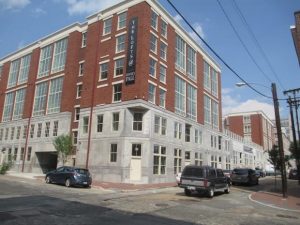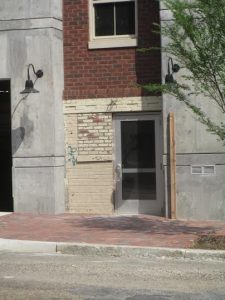After nearly 10 months of fine tuning, Richmond City Council last month approved an updated real estate tax abatement ordinance, closing what it said were loopholes in the popular rehabilitation incentive program.
Developers who qualify for the program pay taxes on a property based on its value prior to any redevelopment or improvements for either five or seven years, depending on the building’s use. In some cases, this system can save a developer millions and encourages the revitalization of buildings that are 20 or more years old.
The changes put new limits on the square footage developers can add to an existing building when seeking a tax abatement, but also made at least one change in their favor.
In seeking the new rules, Councilwoman Kathy Graziano said the program as it was written wasn’t clear enough about what qualified a property for a tax reduction.

Historic Housing qualified for a city real estate tax incentive program to build the Lofts at River’s Fall apartments on 18th and Cary Streets. Photo by Burl Rolett.
“We had some developers who took advantage of our abatement system as it was, or tried to,” Graziano said. “We wanted to tweak it a little bit to make it a little more difficult to circumvent the process.”
Under the previous tax abatement system, developers could connect a massive structure to a small, older building, then claim the project was a renovation of the smaller structure.
David White and Louis Salomonsky of downtown development company Historic Housing sparked talks of a revised system when they moved a 220-square-foot pump house down Cary Street and built their Lofts at River’s Fall apartments on top of it. Having the old structure as a base allowed them to qualify the $20 million apartment project for the development incentive.
The new rules put a limit on how much a developer can add to an existing building when seeking a tax reduction. Now, developers can only earn an abatement on a multifamily structure for square footage increases of 30 percent or less.
They can double the size of an existing property and still earn a full tax abatement if the new building is commercial or mixed-use. The old system only limited building size on projects that demolished old structures and rebuilt.

Historic Housing moved a small building and constructed the Lofts at River’s Fall around it. Photo by Burl Rolett.
White disagreed with the plan to impose limits on the size of a renovation. The Lofts at River’s Fall project would not have qualified for a tax break under the new changes.
White said if Historic Housing had still taken on renovations there, the finished product would have to be a “much cheaper-looking building.”
“I think the abatement program where you had the unlimited addition was not unintentional. It was intentional so you could actually do exactly what we did,” White said. “We were able to do a much nicer product as a result of having the abatement program.”
Some developers also disagreed with a new rule that requires 80 percent of a building’s original exterior walls to be in place to make it eligible for a tax abatement.
Tom Papa of Fountainhead Development said developers could not seek the incentive if just one of four walls had collapsed on an aging building.
“I think there’s a break in the logic of the 80 percent rule,” Papa said. “It’s really kind of the reverse of what you want. The more dilapidated a building, the more you would want somebody to rehabilitate it.”
Last month’s changes drew generally positive reviews from developers, even if some of its individual pieces aren’t sitting well.
The ordinance works in developers’ favor by allowing them to apply for a second abatement while a first is already in place. If a property owner wants to expand the scope of a renovation project, he or she can forfeit the first abatement and the tax rate based on the value of the original property for a new abatement based on the value of the property at that time.
Graziano said that change made sense for the city because it raised the property’s taxable value by taking the existing abatement off the books and encouraged further development that would pay the city again when the second abatement cycled through.
The city tax abatement program freezes a property’s taxable value at the building’s worth prior to renovations. For residential buildings, a property owner only pays taxes on the original structure’s value for seven years while the renovated building’s taxable value is taken out of the owner’s tax liability. The discount tapers off over the following three years by 25 percent a year, and the renovated property’s full value becomes taxable in year 11.
If a developer improves a property for commercial or mixed-use, he or she earns the full tax reduction for five years and then has a two-year taper period with a 66 percent discount in the sixth year and a 33 percent discount in the seventh.
For example, an old warehouse valued at $1 million is converted into an apartment building valued at $10 million. The owner would only pay taxes on the original $1 million for seven years, a $9 million abatement figure.
There is more than $1.8 billion worth of assessed real estate value in the city that cannot be taxed this year because the property qualifies for abatements. That’s 9 percent of the city’s total real estate tax book and accounts for $21.6 million worth of taxes at the current rate of $1.20 per $100 of assessed value.
The largest tax abatement on the city’s books belongs to the Troutman Sanders office building on the Haxall Canal, built in 2005 on top of a then-crumbling coal power plant. Its owners are able to abate up to $63 million from the property’s real estate tax assessment annually.
Bruce Milam, a commercial real estate broker with Colliers International, who spearheaded a recent effort to give developers a unified voice as the new ordinance came together, said the abatement program has had effects beyond just the major downtown developments and fuels projects all the way down to single-family home renovations.
“We see the big buildings being done now – the First National Bank building and the CNB building – and they think it’s all about big buildings, but it’s not,” Milam said. “About 85 percent of the permits that have been pulled on the tax abatement program have been houses.”
After nearly 10 months of fine tuning, Richmond City Council last month approved an updated real estate tax abatement ordinance, closing what it said were loopholes in the popular rehabilitation incentive program.
Developers who qualify for the program pay taxes on a property based on its value prior to any redevelopment or improvements for either five or seven years, depending on the building’s use. In some cases, this system can save a developer millions and encourages the revitalization of buildings that are 20 or more years old.
The changes put new limits on the square footage developers can add to an existing building when seeking a tax abatement, but also made at least one change in their favor.
In seeking the new rules, Councilwoman Kathy Graziano said the program as it was written wasn’t clear enough about what qualified a property for a tax reduction.

Historic Housing qualified for a city real estate tax incentive program to build the Lofts at River’s Fall apartments on 18th and Cary Streets. Photo by Burl Rolett.
“We had some developers who took advantage of our abatement system as it was, or tried to,” Graziano said. “We wanted to tweak it a little bit to make it a little more difficult to circumvent the process.”
Under the previous tax abatement system, developers could connect a massive structure to a small, older building, then claim the project was a renovation of the smaller structure.
David White and Louis Salomonsky of downtown development company Historic Housing sparked talks of a revised system when they moved a 220-square-foot pump house down Cary Street and built their Lofts at River’s Fall apartments on top of it. Having the old structure as a base allowed them to qualify the $20 million apartment project for the development incentive.
The new rules put a limit on how much a developer can add to an existing building when seeking a tax reduction. Now, developers can only earn an abatement on a multifamily structure for square footage increases of 30 percent or less.
They can double the size of an existing property and still earn a full tax abatement if the new building is commercial or mixed-use. The old system only limited building size on projects that demolished old structures and rebuilt.

Historic Housing moved a small building and constructed the Lofts at River’s Fall around it. Photo by Burl Rolett.
White disagreed with the plan to impose limits on the size of a renovation. The Lofts at River’s Fall project would not have qualified for a tax break under the new changes.
White said if Historic Housing had still taken on renovations there, the finished product would have to be a “much cheaper-looking building.”
“I think the abatement program where you had the unlimited addition was not unintentional. It was intentional so you could actually do exactly what we did,” White said. “We were able to do a much nicer product as a result of having the abatement program.”
Some developers also disagreed with a new rule that requires 80 percent of a building’s original exterior walls to be in place to make it eligible for a tax abatement.
Tom Papa of Fountainhead Development said developers could not seek the incentive if just one of four walls had collapsed on an aging building.
“I think there’s a break in the logic of the 80 percent rule,” Papa said. “It’s really kind of the reverse of what you want. The more dilapidated a building, the more you would want somebody to rehabilitate it.”
Last month’s changes drew generally positive reviews from developers, even if some of its individual pieces aren’t sitting well.
The ordinance works in developers’ favor by allowing them to apply for a second abatement while a first is already in place. If a property owner wants to expand the scope of a renovation project, he or she can forfeit the first abatement and the tax rate based on the value of the original property for a new abatement based on the value of the property at that time.
Graziano said that change made sense for the city because it raised the property’s taxable value by taking the existing abatement off the books and encouraged further development that would pay the city again when the second abatement cycled through.
The city tax abatement program freezes a property’s taxable value at the building’s worth prior to renovations. For residential buildings, a property owner only pays taxes on the original structure’s value for seven years while the renovated building’s taxable value is taken out of the owner’s tax liability. The discount tapers off over the following three years by 25 percent a year, and the renovated property’s full value becomes taxable in year 11.
If a developer improves a property for commercial or mixed-use, he or she earns the full tax reduction for five years and then has a two-year taper period with a 66 percent discount in the sixth year and a 33 percent discount in the seventh.
For example, an old warehouse valued at $1 million is converted into an apartment building valued at $10 million. The owner would only pay taxes on the original $1 million for seven years, a $9 million abatement figure.
There is more than $1.8 billion worth of assessed real estate value in the city that cannot be taxed this year because the property qualifies for abatements. That’s 9 percent of the city’s total real estate tax book and accounts for $21.6 million worth of taxes at the current rate of $1.20 per $100 of assessed value.
The largest tax abatement on the city’s books belongs to the Troutman Sanders office building on the Haxall Canal, built in 2005 on top of a then-crumbling coal power plant. Its owners are able to abate up to $63 million from the property’s real estate tax assessment annually.
Bruce Milam, a commercial real estate broker with Colliers International, who spearheaded a recent effort to give developers a unified voice as the new ordinance came together, said the abatement program has had effects beyond just the major downtown developments and fuels projects all the way down to single-family home renovations.
“We see the big buildings being done now – the First National Bank building and the CNB building – and they think it’s all about big buildings, but it’s not,” Milam said. “About 85 percent of the permits that have been pulled on the tax abatement program have been houses.”
